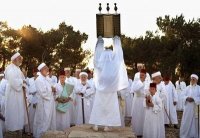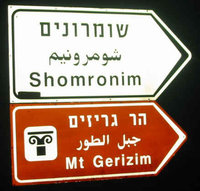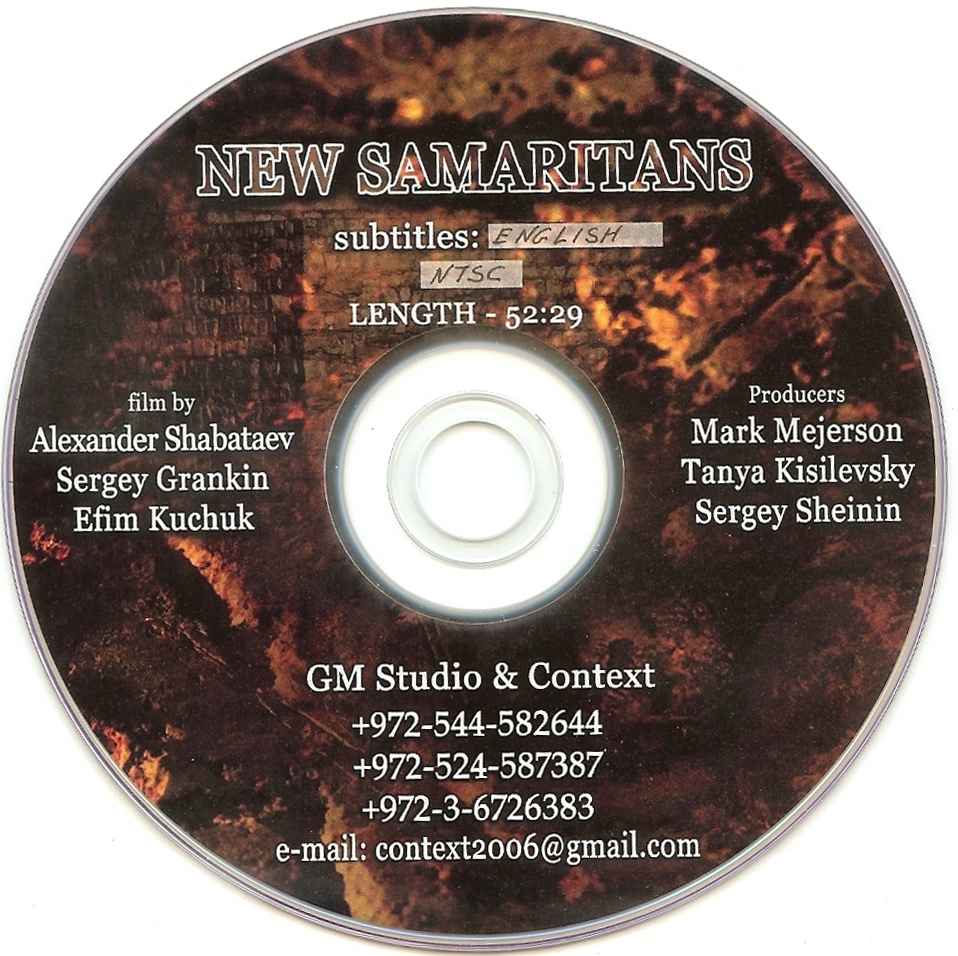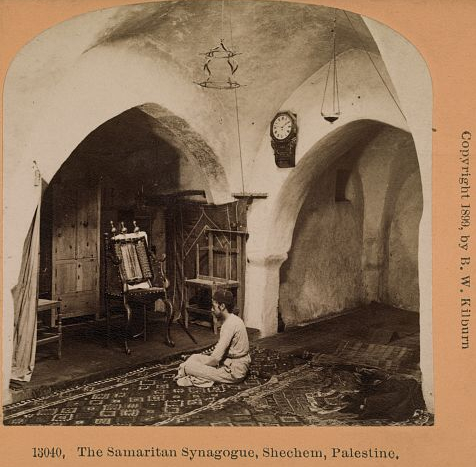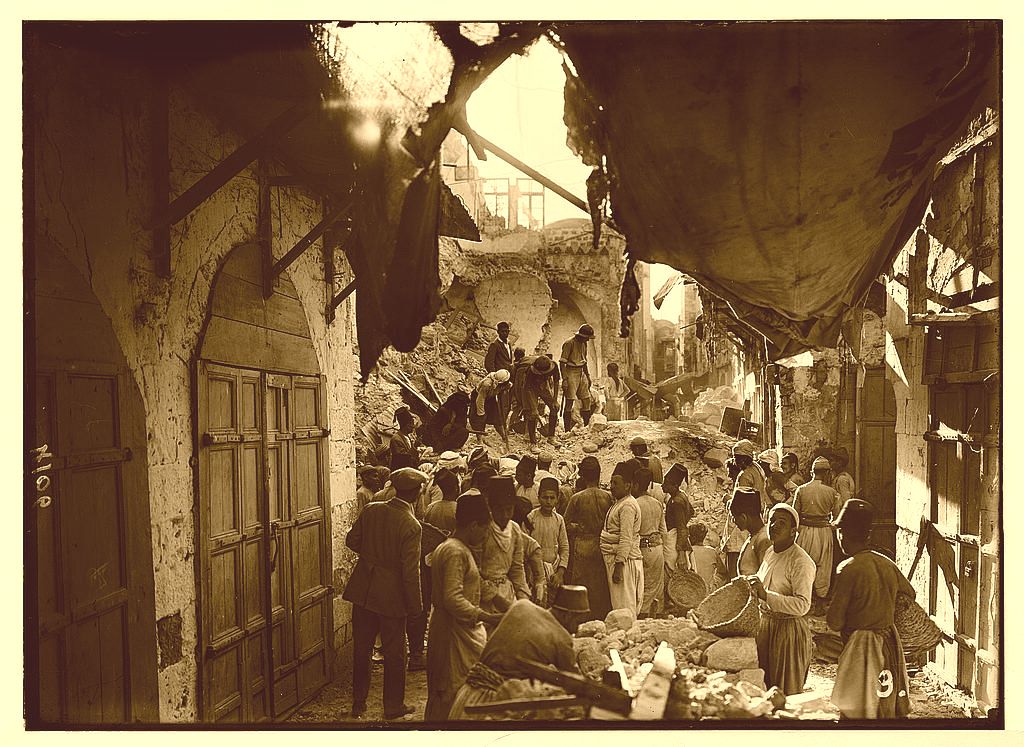
|
Nov/ Dec 2010 |
Vol. X - No 2 |
|
|
In This Issue · The Fifth · Manuscript · Kohen · Tales · Journal · Travels · Evidence · Ch life · Text · Links · Biblio
The
Samaritan Update, is a Bi-Monthly Internet Newsletter ----- Editor: Larry Rynearson ----
Contact information:
The Samaritan Update is trying something new. Please give us your feedback! 
Choose a language to translate this page!
Subscribe To the Newsletter -The
Samaritan Update. Sign Up ! The Samaritans call themselves Bene-Yisrael (“Children of Israel”), or Shamerim (“Observant Ones”) Hebrew: שומרונים Shomronim, Arabic: السامريون as-Sāmariyyūn
Samaritan Studies and Related Conferences:
SBL Annual Meeting
The 2010
Annual Meeting will be in Atlanta The SBL Annual Meeting is the largest gathering of biblical scholars in the world.
2011 International Meeting
Meeting Begins:
7/3/2011 Call For Papers
Opens: 10/1/2010
View the 2011 International Meeting Program Units >>
Book mark the Samaritan Studies (EABS)
Keep Up with the Samaritan Basketball team on FANS of Samaritan basketball team
Community Youth Club Samaritan on Facebook.com SAMARITAN MYTHسطورة السامريةהאגדה השומרונית الا
A group of young Samaritans people who is interested in their culture, heritage and the future of their small community, we establish an association which is called Samaritan myth. This association is aimed on the definition of Samaritan's culture and heritage the internal and external one. |
One Fifth of the Tiny Samaritan Community in Nablus Died in the Plague Epidemic of 1786 Haseeb Shehadeh A three-page narrative of the plague epidemic of 1786 and its tragic consequences for the Samaritan community of Nablus have been preserved in MS BL. Or. 2691. This manuscript has been preserved on microfilm number 8437, housed at the Institute of Microfilmed Hebrew Manuscripts in the Jewish National and University Library in Jerusalem. The manuscript contains 42 folios, with Arabic poetry by various authors, including El->Ayyeh himself, found at the beginning and at the end of the manuscript; a commentary on Deuteronomy 32; and a report on the events of the plague epidemic. Many of the poems in this manuscript may be found in Kitab Al-Tasabich (sic) (The Book of Commendations), edited and published by Ratson Tsedaqa Hassafarey (Óolon, 1970, 443 pp.). Part of the manuscript was prepared towards the end of the eighteenth century, and the rest was copied at the end of the nineteenth century. The report on the plague epidemic, which is probably incomplete, is annotated and published for the first time in this article. I have added some 61 linguistic observations at the end of the article as well as in marginal notes. As the reader will observe, some of the words in the report have been indecipherable.
Continue reading (English after the Arabic) at https://shomron0.tripod.com/plgueepidemicof1786.pdf
A Photo of the July 1927 Earth Quake in Nablus ~~~~~~~~~~~~~~~~~~~~~~~~~ Also read the Synopses from Haseeb Shehadeh
New Samaritan Manuscripts in East Jerusalem Samaritan manuscripts exist in approximately seventy public libraries around the world. The number of manuscripts can be estimated at over 2,500; the lion’s share, some 1,350 manuscripts, can be found in the National Library of Russia in Saint Petersburg. Almost all are fragmentary, and they have been classified into fourteen categories in accordance with their subject matter.
The Kohen Jacob ben >Uzzi’s Letter to Yitshak Ben -Zvi in 1937 This three-page Arabic letter, written in 1937 by the Samaritan high priest Jacob (Ya>q¥b) ben >Uzzi ben Jacob ben Aaron ben Shalma ben Tabia (Ghazål) (1899-1987), to Yitshak Ben- Zvi, the second president of Israel (1884-1964), is being published and annotated here, translated into Hebrew for the Samaritans of Óolon and others interested in Samaritanism who are not familiar with the Arabic language. This letter is not dated, but it answers a letter written by Yitshak on 5 March 1937, which contained eight questions. These questions concerned one main issue:
A Poem in Praise of Moses, the Lord of Mankind, by Ibråh•m El->Ayyeh This Samaritan Arabic poem (qaß•ida) by the versatile and prolific eighteenth-century scholar, Ibråh•m ben Ya>q¥b ben Mur≠ån (Ab Sakwa = Sikkuwwa) al-Danf• (known by the nickname El->Ayyeh, c. 1719-1786), is published here and annotated for the first time. As far as we know, this is the longest poem in the Samaritan Arabic literature which emerged in the eleventh century. The poem written in 1194 H./1780 A.D. consists of 417 lines (one line has been added in the margin) in accordance with the manuscript which we utilised. A Sample of Samaritan Tales An Arabic translation of twenty-one Samaritan tales written in modern Hebrew is presented here along with annotations. These tales were published a decade ago in a volume entitled: The Samaritans: Cooking, Traditions and Customs, written and photographed by Dan (Dantsu) Arnon. The volume also contains forty-three recipes by Batia Tsedaka and her sister Zippora Tsedaka. Tel Aviv 1999 (in Hebrew). The tales were narrated by twelve Samaritans including Ratson Tsedaka (1922-1990) with six tales, Íabr• b. Ismå>•l al-Danf• with two tales, and Tsedaka b. Is˙åq al-Kåhin, with one legend. Among these storytellers there is only one woman, Batia Tsedaka (1925-2010), with one tale.
Continue reading at https://shomron0.tripod.com/HaseebShehadehSynopses2010.pdf ~~~~~~~~~~~~~~~~~~~~~~~~~
From the Editor's personal Library: I have decided to share a sections from a couple books. The full book sections that topic on the Samaritans can be found our Samaritan Resources at TheSamaritanupdate.com. Enjoy the following: JOURNAL OF A TOUR IN THE HOLY LAND IN MAY AND JUNE, 1840 BY LADY FRANCIS EGERTON Page 51) They next produced an original letter, written to them by some Samaritan brethren in India about 160 years ago. The occasion of its being written was this: 160 years ago, an Englishman of the name of Roberts, informed the Samaritans of Nablous of the existence of some of their brethren in India. Upon this the Nablous Samaritans sent them a copy of the Pentateuch, but with one chapter short, with a view to ascertaining whether they would discover the omission. They did discover it, as the letter will show. In return for this the Indian Samaritans sent to their brethren of Nablous, a printed copy of the Pentateuch, in three or four languages, together with the subjoined letter; both of which were shown to us. They were obliging enough to send us a copy of this letter, translated into Arabic. Assaad having interpreted it for us, I have given it below. (Page 52) Letter of the Samaritans of India to those of Nablous. “In the name of God, our God, who has built up our souls by his righteousness, who has sent Moses his Prophet and, by his hand, his Law;- Who has commended to us, and caused to exist, the Holy Mountain of the Statues, (Mount Gerizim,) and the House of the Almighty; we send our peace, O Israel our brethren, who dwell in the Holy Land of Canaan with the great priest, Peace be unto you! **** We inform you that your letter has come unto us, and we learn that you are the holy people, pure from all uncleanness, and that amongst you are men of learning and ability. We have noticed your sweet words, also the Bible which you have sent has reached us. It is a holy faithful law, but it is short one chapter. Blessings be upon all Israel! You have also mentioned the keeping of the Sabbath and the feast. We do what you do. One law is come unto us both, with the exception of the Passover. (Which they can only sacrifice on Mount Gerizim.) We pray every evening and morning, and all the unclean things you have mentioned. We have a high-priest full of all learning, honouring the name of the Most High. He is descended from Phineas, the son of Eleazar, and he dwells in the (page 53) city of Aknuz. He numbers his flock twice a year, and in this year their number is 127,968. The Levites are 2600, and they dwell in seven provinces. We are under the government of the Afingay; (query, Affghan) Every year we pay them each man one shekel of the shekels of Jerusalem. The name of the chief we have now is Zdud, of the tribe of Ashur, and for forty years he has dealt in righteousness, and employed all his energies in preventing evil. He dwells in the city of Aknuz, the largest in our country. We have seventy elders and I am one of them, and my name in Joseph, the son of Gilead of the sons of Nun. We have governors and learned men, and we have twelve judges. Our prayers are many, and each feast has its own prayer. On each Sabbath we take our books and read the lessons to the people, on the feast we take out the fire, as also on the tenth day of the fast. **** The day of our fasting is not like that of the Jews, for we have abstained from their ways. In the time of prayers we sing hymns and read a chapter of Joshua and the ten commandments. We calculate the time in a true way, and we know the eclipses of the sun and moon, and thus we know the beginning of the year, the month of (page 54) April and the seventh month. We cannot reach the land of our Fathers. We do not burn fire on the Sabbath-day, or on the day of atonement. **** We pay tithes to the Levites, and also make offerings to God as Moses has commanded. You have requested us to send you a book of the Law; the Law is one , (meaning that having one law in common, it was unnecessary to sent it; they did, however, send a copy of the Pentateuch,) and you have asked of us two men of learning. Know ye, O our brethren, that we cannot reach you by sea on account of the Sabbath, (alluding to the Jewish law, which does not admit of travelling on the Sabbath-day,) but if you can send us any person we will pay his expenses. (It appears they were less scrupulous on this head for their friends than for themselves.) We beseech you to salute on our part the High Priest, and our brethren the elders, so that they may intercede for us, and we shall do the same for them. *** Send us the book of Joshua, the son of Nun, as also the book of Prayers, and inform us whether the altars still exist on the Mount of the Covenant (or statues), and whether the rock of the Word (or Joshua’s altar) is still preserved, and whether you are walking as he ordered you. Whether the Messiah is come, and what is his name. Give (page 55) us the details of all this, and the names of the cities in which you dwell, that we may know the facts. Also how many wives you take, for we cannot take more than two by the law, but the sons of Judah take four. But it is better for us to keep the statues of our fathers, as they were delivered by the hand of Moses our Lord. May God take you, and cause you to reside on the mountain of His Majesty! May he raise you in the day of resurrection, and may He reward you according to His riches! And now be not backward in writing to us, for your letters are very delightful, like the books of the law. *** “We have written this, 20th April, year of the world, 6112.” The full book section can be read in PDF format at https://shomron0.tripod.com/journalholyland1840egerton.pdf MISSIONARY JOURNAL AND MEMOIR OF THE REV. JOSEPH WOLF, MISSIONARY TO THE JEWS. (Page 199)…. Dec. 29, - Mr. Joseph Damiani introduced me to-day to Israel, from Naplus, (Sichem,) Scrivano to a Turkish merchant at Jaffa. He is one of the few descendants of the Samaritans residing at Naplus. He received me with great cordiality; I addressed myself to him in the Hebrew tongue, he was only able to understand the expression Lasan hakodesh, (the holy language.) I asked him whether he spoke the holy language (the Hebrew); he showed me three Samaritan manuscripts, the first contained the fourth part of the books of Moses, the second, a book called Mimar, old sermons of their priests, which (page 200) he affirmed were above 1600 years old, and the third manuscript contained a catechism for the Samaritan youth, which consisted of the Ten Commandments of Moses; all these manuscripts were written in the Samaritan language, which I was not able to read. Israel is of an amiable countenance; another Samaritan was there also. I. Do you sell these books? Israel. No Samaritan will ever sell his books. I. Are you in the possession of the Prophets and the Psalms of David? Israel. We do not acknowledge any other prophet besides Moses; we do neither acknowledge Isaiah, nor Jeremiah, nor Ezekiel, nor Psalms of David; nothing. Nothing, nothing but the books of Moses: we also despise the Talmud and the Mishna. There is much to be found in the books of Moses, not every one is able to understand them, or enter into the depth of them. I. Why do you not believe in the Prophets? The full book section can be read in PDF format at https://shomron0.tripod.com/missionaryjosephwolf.pdf TRAVELS AND ADVENTURES OF THE REV. JOFEPH WOLFF Wolff left Gaza on the 28th of December 1821, and on reaching Jaffa took up his abode in the house of Antonio Damiani, whose father was consul there for 80 years; and he himself was a venerable old man, with a three-cornered hat, and a gold-lace brim upon it. He wore a large coat of taffeta, and carried a staff in his hand, with a silver button at the top of it. At Wolff’s request, on his hearing that some Samaritans were there, be bought to him the most learned of them. His name was Israel; he came from Bablous, and was in correspondence with Abbe-Gregoire, at Paris, bishop of Blois. Lord Guildford, who was known there as Lord North, was also one of this Samaritan’s correspondents. He showed to Wolff three Samaritan manuscripts; the first was part of the books of Moses; the second was a book called Mimra, containing old sermons of their priests; and the third contained a catechism for the Samaritan youth. All these were written in the Samaritan language. Wolff asked Israel whether he would sell them? ..... .......But what is remarkable- very much so indeed- is, that Jelebee, on arriving in England, was most anxious to visit Dr. Wolff. And when this poor Samaritan arrived at Ile Brewers, neither Dr.. Wolff nor his wife were at home; and as the servants The full book section can be read in PDF format at https://shomron0.tripod.com/travelsjofephwolff.pdf ~~~~~~~~~~~~~~~~~~~~~~~~~ The Evidence from the Articles. By the Editor If you read the sections from the two book, you will find that the two authors, Rev. Joseph Wolfe and Rev. Jofeph Wolff are actually the same person, just different published names. We find a curiosity of who Israel and Jelebee are? According to Binyamin Tsedaka, Editor of the Samaritan AB News, ‘Jelebee is Jallabi or Shallabi = Handsome. It is a name of one of the four branches of the Danfi household among the Samaritans of the present. Shalabi was indeed the nickname of Yacob ElShalabi or ElJalabi. The nick name Shalabi was first given to Jacob's father - Tsedaka [private name] because he was very handsome indeed.' Jacob's father was Yoseph esh Shelaby. Binyamin writes, 'Yacob was a famous Samaritan personality that escaped from Palestine at the middle of the 19th century from the fear of his Arab enemies. He stayed in London but made a mistake pretending to be the High Priest of the Samaritans to collect donations from generous Englishmen. The Government of her excellency Victoria (England) learned of is cheating way and they forced him to leave, going back to Palestine. He was rejected first by the Community in Nablus but after donating sums from the money as a ransom of which he collected in England, the Samaritans agreed to accept him back. He had a strong personality although he was illiterate and once again became one of the heads of the small community. He was one of the partners involved in the big sale of 1348 manuscripts of groups of fragments today in the Firkovitz collection in St. Petersburg. He himself had taken, without permission of the High Priest 'Amram b. Shalma, 32 handwritten complete books from the synagogue in Nablus and sold them separately to Firkovitz and now they are in the library of the University of St. Petersburg.' Shalabi (born in 1829) had 5 sons: Benyamim, 'Aziz, Shalabi, Farid and Chilmi. 'Aziz and Shalabi were known as fine scribes of Torah and prayer books. Binyamin
adds, 'The
Shalabi family has ceased in the beginning of the 2000's. They lived
many years in Salt, East Jordan and
finally they returned to live in Nablus. One member of the family moved
to Holon after 1967. The one of the two daughters of Shalabi is still
alive, her name is Shalabiyyeh and she is over 90 years old, open minded
and very good chef in the kitchen. She was married to Marchiv b. Shelach,
the Marchivi that died in 1964. She has three sons today and two
daughters, the three sons live in the Mount
Gerizim neighborhood and the two daughters in Holon. The other
daughter of Shalabi was Machasen, who married to Nur b. Abraham Tsedaka
and she died in the 1980's.'
Article in The Chistian Life, a Unitarian Journal, vol. XIIL- No.564, London: Saturday, March 5, 1887 CORRESPONDENCE THE SHEIKH OF THE SAMARITANS- HIS VISIT TO ENGLAND: APPEAL FOR HELP. Sir, -will you allow me to call the attention of your readers to the presence in England of Sheikh of the ancient Samaritan people, Jacob-Esh Shellaby! Anyone who has been at Nablous will remember the beautiful valley, and the little town nestling among the gardens under the slopes of Gerizim, where the Turkish governor's house stands conspicuous; nor will he have forgotten the quint and venerable little synagogue, which is the religious home of these long-descended heretics. The present head of the community (who is mentioned by Dean Stanley, "Sinai and Palestine," p. 248 sq., note on Mount Gerizim) was elected in 1874. His people now number only 135. He is the patriarch of his clan; "All we Samaritans," he says in his broken English, "one family." Those who heard the late Keshuh Chunder Sen describe the family house in Calcutta, comprising about a hundred persons, in which he was brought up, will readily understand how Shellaby should give shelter to no less than seventy-two of his co-religionists, mostly women and children, under his own roof. "Not like England," he says, "we sleep six, seven, ten in one room." Would, indeed, that it were not like England, or at least like London. The object of his visit is to raise the sum of £200, to redeem some land belonging to his community, recently mortgaged on ruinous terms to meet the Turkish exactions. Of late years these have become unusually severe. "Governor, he take one taxes, two taxes, three taxes, four taxes, all in one year. But the Sultan, he get very little of the money." The land yields corn, grapes, cotton, and other crops. There is scarcely any trade in Nablous. One or two of the Samaritans deal in stuffs from Damascus. A few others carry vegetables and such like garden produce on donkey-back from the valley to the hill villages around. But without their land their means of living are seriously diminished, and the danger of bondage or of extinction presses on the tribe. Shellaby is personally known to Canon Liddon, who has helped him with a donation of £5, and hearty letter of commendation. The Catholics have not unnaturally declined to aid; and even the liberal Jews still prefer to have no dealings with the Samaritans. The matter presses. Shellaby has been in London for seven weeks, in a dismal attic in a by street off Fitzroy-square. He does not know how to plead his cause. Meanwhile his people are entreating him urgently to return. Will any friends send me any help for him! I shall be glad of any contributions, an obscure appeal like this may easily pass unnoticed. But this time it is the Samaritans who has fallen among thieves. Are any Englishmen disposed to be neighbours to him? J. Estlin Carpenter. 19, Fitzjohn's avenue, London, N.W., February 27th. ~~~~~~~~~~~~~~~
On the Supposed Samaritan Text of the Septuagint Recently I ran across another book, "The Ecclesiastical Gazette" 1853. Page 21 reviewed information of a book edited by John Kitto, The Journal of Sacred Literature, 1848, vol II, C. Cox, 12, King William Street, Strand, Oliver and Boyd, Edinburgh; and j. Robertson, Grafton Street, Dublin, 1848. In the collection of works is an article, 'On the Supposed Samaritan Text of the Septuagint,' (pages 324-332) by the Rev. W. Fitzgerald, M.A., Professor of Moral Philosophy in the University of Dublin. The 1st paragraph is specially interesting: 'The question which has been raised, Whether the translation of the Pentateuch by the Seventy was from MSS, in the Samaritan recension, or from our present Hebrew text? is one which it is very difficult to answer precisely either way. The more prevalent modern opinion is in favor of the hypothesis that the translation was made from MSS. of Samaritan recension.'
Look for this article coming soon in our archives of the Samaritan Update. Journal of Sacred Literature, April 1853 to July 1853 By John Kitto, article is 'On the Samaritan Pentateuch' by W.E.T. (pages 298 -327) Kessinger Publishing Co (28 April 2003) On John Kitto see http://www.pitts.emory.edu/Archives/text/mss270.html ~~~~~~~~~~~~~~~ Want to translate something! Use http://translate.google.com/
~~~~~~~~~~~~~~~ Samaritan Pentateuch Font Needed
Anyone that has a Samaritan font for Mac, please contact the editor
~~~~~~~~~~~~~~~ Links
Old-time religion in new-fangled (sort of) Israel 08/04/2010 by Sue Swartz One of the great things about having sabbatical in Israel in 2007 was the experience we had over and over of realizing Whoa! This place in mentioned in the Torah! They weren’t kidding us! Familiar names were everywhere, history laid out before us. Let me tell you specifically about my run-in with Mount Gerizim and Mount Eval, twin peaks mentioned at the beginning of this week’s Torah portion. http://swartzsue.wordpress.com/2010/08/04/mount-gerizim/ ~~~~~~~~~~~~~~~ One God Supreme: A Case Study of Religious Tolerance and Survival by Michael Meerson ~~~~~~~~~~~~~~~ New Biblios For a relatively recent description of the archaeological finds on Gerizim see: Magen, Yitzhak. “Bells, Pendants, Snakes & Stones — A Samaritan Temple to the Lord on Mt. Gerizim.” Biblical Archaeological Review 36, no. 6 (November/December 2010): 26–35, 70. Journal of a Tour in the Holy Land in May and June, 1840 by Lady Francis Egerton, 1841 London, By Harrison and Co. The Chistian Life, a Unitarian Journal, vol. XIIL- No.564, London: Saturday, March 5, 1887- Correspondence- The Sheikh of the Samaritans- His Visit to England, Appeal for Help
Travels and Adventures of the Rev. Jofeph Wolff,; D.D., LL.D., Vicar of Ile Brewers, near Taunton; and Late Misionary to the Jews and Muhammadans in Persia, Bokhara, Cashmeer, Etc. London: Saunders, Otley and Co., 66 Brook Street, Hanover Square, W. 1861 Missionary Journal and Memoir of Rev. Joseph Wolf, Missionary to the Jews. Written by himself, revised and edited by John Bayford, Esq. F.S.A., London: Sold by John Duncan 1824 The Late Dr. Charles Beke's Discoveries of Sinai in Arabia and Midian Edited by his widow, London, Trubner & Co. 1878
TheSamaritanupdate.com . Copyright 2010 Credit is given to the author or website of the internet link and is only displaced here for educational reasons. |


